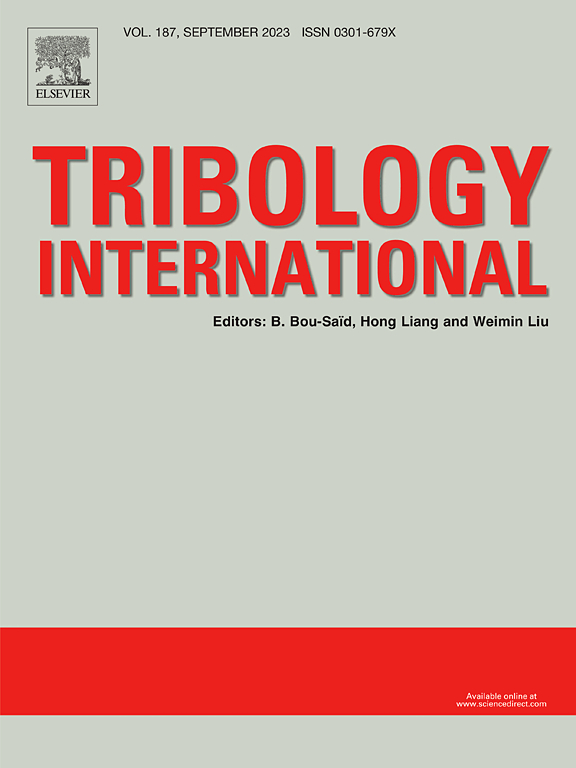Influence of the content of (NaPO3)6 on the properties of microarc oxidized coatings on non-valve metal-copper
IF 6.1
1区 工程技术
Q1 ENGINEERING, MECHANICAL
引用次数: 0
Abstract
In this paper, for the first time, by adding (NaPO3)6 additives to the aluminate electrolyte, a MAO coating with good performance was successfully prepared on the surface of T2 copper, a non-valved metal, and the effects of (NaPO3)6 content on the organization, abrasion and corrosion resistance of the coatings were comprehensively and systematically investigated. Most importantly, this method of preparing MAO coating on non-valve metal surface does not need any pretreatment or high current density. The results obtained demonstrated that the incorporation of the (NaPO3)6 additive facilitated the direct deposition of MAO coatings on the surface of non-valve metal-T2 copper, with an increase in coating thickness and roughness observed as the (NaPO3)6 content rises. The compositions of the coatings included CuO, Cu2O, α-Al2O3, CuAlO2, Cu(OH)2 and amorphous AlPO4. The content of Cu-containing compounds in the coatings exhibited an initial increase, followed by a subsequent decrease, with the increase of (NaPO3)6 content. The highest percentage (14.39 at%) of elemental Cu was observed when the content of (NaPO3)6 was 10 g/L and it was observed that the coating exhibited the lowest average surface porosity (8.29 %) at this content level, in addition to the highest hardness (890.18 HV) and minimum wear depth (4.78 μm) and average COF (0.161) for a load of 10 N. Three different wear mechanisms (adhesion, abrasive grain and delamination wear) were found on the wear scars. The coating showed the best corrosion resistance with an icorr of 4.0257 × 10–6 A/cm2 at a (NaPO3)6 content of 15 g/L, which was four orders of magnitude lower than the substrate.
(NaPO3)6含量对无阀金属-铜微弧氧化镀层性能的影响
本文首次通过在铝酸盐电解液中添加(NaPO3)6添加剂,在非阀金属T2铜表面成功制备了性能良好的MAO涂层,并全面系统地研究了(NaPO3)6含量对涂层组织、耐磨性和耐腐蚀性的影响。最重要的是,这种在非阀金属表面制备 MAO 涂层的方法不需要任何预处理或高电流密度。研究结果表明,(NaPO3)6 添加剂的加入促进了 MAO 涂层在非阀金属-T2 铜表面的直接沉积,随着(NaPO3)6 含量的增加,涂层厚度和粗糙度也随之增加。涂层的成分包括 CuO、Cu2O、α-Al2O3、CuAlO2、Cu(OH)2 和无定形 AlPO4。涂层中的含铜化合物含量随着(NaPO3)6 含量的增加而先增加后减少。当(NaPO3)6的含量为10 g/L时,观察到元素铜的百分比最高(14.39 at%),并且观察到在此含量水平下,涂层的平均表面孔隙率最低(8.29 %),此外,在负载为10 N时,硬度最高(890.18 HV),磨损深度最小(4.78 μm),平均COF(0.161)。在磨损疤痕上发现了三种不同的磨损机制(附着磨损、磨粒磨损和分层磨损)。涂层显示出最佳的耐腐蚀性,在 (NaPO3)6 含量为 15 g/L 时,icorr 为 4.0257 × 10-6 A/cm2,比基体低四个数量级。
本文章由计算机程序翻译,如有差异,请以英文原文为准。
求助全文
约1分钟内获得全文
求助全文
来源期刊

Tribology International
工程技术-工程:机械
CiteScore
10.10
自引率
16.10%
发文量
627
审稿时长
35 days
期刊介绍:
Tribology is the science of rubbing surfaces and contributes to every facet of our everyday life, from live cell friction to engine lubrication and seismology. As such tribology is truly multidisciplinary and this extraordinary breadth of scientific interest is reflected in the scope of Tribology International.
Tribology International seeks to publish original research papers of the highest scientific quality to provide an archival resource for scientists from all backgrounds. Written contributions are invited reporting experimental and modelling studies both in established areas of tribology and emerging fields. Scientific topics include the physics or chemistry of tribo-surfaces, bio-tribology, surface engineering and materials, contact mechanics, nano-tribology, lubricants and hydrodynamic lubrication.
 求助内容:
求助内容: 应助结果提醒方式:
应助结果提醒方式:


